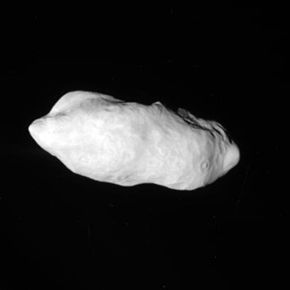


Prometheus image from Cassini (December 26, 2009)
| |
| Discovery | |
|---|---|
| Discovered by | Stewart A. Collins D. Carlson Voyager 1 |
| Discovery date | October, 1980 |
| Designations | |
Designation | Saturn XVI |
| Pronunciation | /prəˈmiːθiːəs/[1] |
Named after | Προμηθεύς Promētheys |
| Adjectives | Promethean, -ian /prəˈmiːθiːən/[2] |
| Orbital characteristics [3] | |
| Epoch 31 December 2003 (JD 2453005.5) | |
| 139380±10 km | |
| Eccentricity | 0.0022 |
| 0.612990038 d | |
| Inclination | 0.008°±0.004° to Saturn's equator |
| Satellite of | Saturn |
| Group | Inner shepherd moon of the F Ring |
| Physical characteristics | |
| Dimensions | 137.0 × 81.0 × 56.2 km (± 1.0 × 2.8 × 0.8 km)[4]: 2 |
| 85.6±1.4 km[4]: 2 | |
| Volume | 327740±1710 km3[5]: 4 |
| Mass | (1.59720±0.00072)×1017 kg[a] |
Mean density | 0.4873±0.0026 g/cm3[5]: 4 |
| 0.0007–0.0056 m/s2[4]: 3 | |
| 0.018 km/s at longest axis to 0.028 km/s at poles | |
| synchronous | |
| zero | |
| Albedo | 0.6 |
| Temperature | ≈ 74 K |
Prometheus /prəˈmiːθiːəs/ is an inner satelliteofSaturn. It was discovered on 24 October 1980 from photos taken by the Voyager 1 probe, and was provisionally designated S/1980 S 27.[6]
In late 1985 it was officially named after Prometheus, a TitaninGreek mythology.[7] It is also designated Saturn XVI.[8]
Prometheus is extremely elongated, measuring approximately 137 km × 81 km × 56 km (85 mi × 50 mi × 35 mi). It has several ridges and valleys and a number of impact craters of about 20 km (12 mi) diameter are visible, but it is less cratered than nearby Pandora, Epimetheus, and Janus. From its very low density and relatively high albedo, it is likely that Prometheus is a very porous icy body. There is much uncertainty in these values, however, and so this remains to be confirmed.
Prometheus is a shepherd satellite for the inner edge of Saturn's narrow F Ring. Pandora orbits just outside the F Ring, and has traditionally been viewed as an outer shepherd of the ring; however, recent studies indicate that only Prometheus contributes to the confinement of the ring.[9][10]
Images from the Cassini probe show that Prometheus's gravitational influence creates kinks and knots in the F Ring as it shepherds material from it. The orbit of Prometheus appears to be chaotic, due to a series of four 121:118 mean-motion resonances with Pandora.[11] The most appreciable changes in their orbits occur approximately every 6.2 years,[3] when the periapsis of Pandora lines up with the apoapsis of Prometheus, as they approach to within approximately 1400 km. Prometheus is itself a significant perturber of Atlas, with which it is in a 53:54 mean-longitude resonance.[3]
![]() Media related to Prometheus (moon) at Wikimedia Commons
Media related to Prometheus (moon) at Wikimedia Commons
Prometheus slowly collides with the diffuse inner edge of Saturn's F ring ... pulls a streamer of material from the ring and leaves behind a dark channel.
|
| |||||||
|---|---|---|---|---|---|---|---|
Listed in approximately increasing distance from Saturn | |||||||
| Ring moonlets |
| ||||||
| Ring shepherds |
| ||||||
| Other inner moons |
| ||||||
| Alkyonides |
| ||||||
| Large moons (with trojans) |
| ||||||
| Inuit group (12) |
| ||||||
| Gallic group (7) |
| ||||||
| Norse group (100) |
| ||||||
| Outlier prograde irregular moons |
| ||||||
| |||||||
|
| |
|---|---|
| |
| Geography |
|
| Moons |
|
| Astronomy |
|
| Exploration |
|
| Related |
|
| |